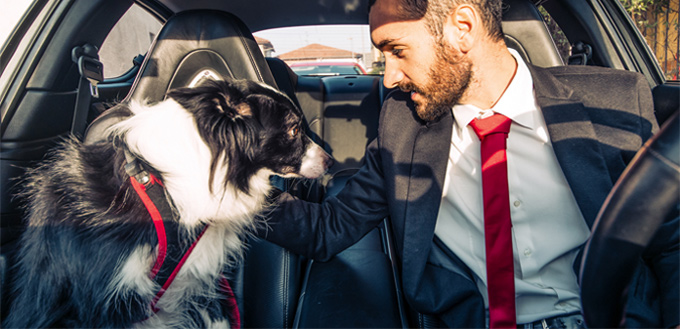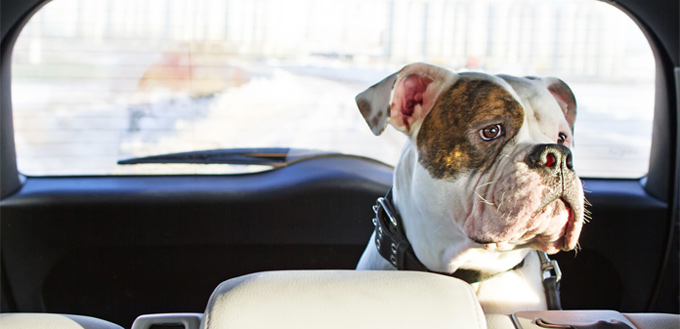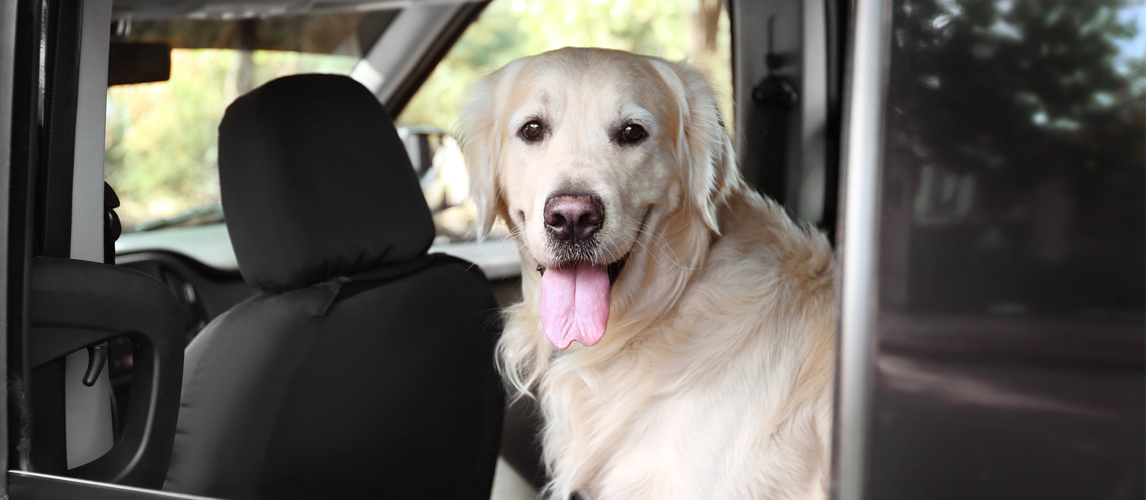Most of us know the terrible feeling of car sickness. The queasiness that builds up in the pit of your stomach until you are too ill to even talk for fear of being sick. Staring out the car window, wishing desperately that the journey would just end. If it gets too bad, you might just muster up the strength to plead, ‘Stop the car, I need some air’, or words to that effect. But, have you ever considered if your dog could have the same experience? Dogs can’t speak up if they are about to throw up, so how can you tell, and what can you do about it?

Can Dogs Get Car Sick?
Yes, they can! It’s not something we often think about, but animals can suffer from motion sickness just like humans do. Puppies are particularly susceptible, and many owners have had the unpleasant experience of taking their new pup to the vet, or even on a fun adventure, only for them to make a mess in the car.
Like humans, dogs and puppies get car sick because of issues relating to ear structure and balance as their brains struggle to interpret the signals being sent to it. The reason why children and puppies are more likely to get car sick is because their ears are still developing, which can be made worse by their smaller size. Luckily, this improves as they get older and many adult dogs simply grow out of car sickness.
Genuine motion sickness can often be only the initial cause of car sickness in dogs, however. Many dogs who continue to struggle with travel as they grow up may be suffering for another reason.
Conditioned Car Sickness
It is possible that your dog is suffering due to their own association between car journeys and illness, or unpleasant memories, rather than due to a genuine biological effect. If any of the symptoms which we outline below regularly plague your dog during car journeys, particularly if they are an adult dog, it is worth considering whether your best friend has been accidentally conditioned to feel ill in the car.
Conditioning can happen in two ways. Experiencing car sickness as a puppy may cause an adult dog to connect being sick with the car, which causes them to throw up or demonstrate other symptoms of car sickness whenever they are traveling by car. It is also possible that, if you mostly use cars to transport your pet to negative places such as the vet, your dog’s car sickness could be more related to anxiety.
If you think this is the case, the earlier you pick up on it, the better. It is very possible to train your dog out of conditioned motion sickness, so learning about the symptoms is important for all dog owners.
How to Tell if Your Dog Is Car Sick
You might think that your dog is fine in the car just because they have never thrown up, or at least haven’t thrown up since they were a pup. But this may not be true. Many dogs exhibit other symptoms but are suffering just as much.
Watch out for these symptoms when you bring your dog in the car to see if they are one of the many dogs who suffer from car sickness:
- Vomiting
- Inactivity
- Uneasiness
- Whining
- Yawning
- Licking lips
- Increased drooling
You know your pet best, so watch out for any behavior that is unusual. If your pet seems in any distress or discomfort, it is worth reading the following tips, even if they aren’t physically ill.
Comfort
While having a puppy is a meaningful experience, it is also often a messy challenge; and never is this truer than when they vomit on you in the back of the car. So, how can you make your dog more comfortable in the car to avoid this tricky situation?
For most dogs, the most effective, and simplest, the solution is to work at making car journeys more pleasant and comfortable for them. Here are four easy and simple ways that you can make your best friend just a little bit more comfortable:
- Make sure they face forward
One way that dogs, and people, can become car sick is due to the confusing visuals they are faced with as the brain becomes confused as to whether they are moving or not. In order to limit this confusion, you should ensure your dog is facing forward. This might sound difficult, but some owners have found that placing your dog in a crate can help them to remain facing forward. If you don’t think a crate will help it is possible to invest in a dog seatbelt. These are specially designed to keep a dog in place.
You may also like our guide on the Best Dog Crates.
- Keep the air and oxygen flow
Air pressure in cars is often another cause of car sickness, as well as a lack of oxygen. This is often why dogs might yawn when they are feeling car sick. While you may not want to have your windows completely open while your dog is in the car, you don’t want them hopping out at a stop sign, after all, cracking your windows open a couple of inches is going to seriously help your pet to feel better.
- Control their food
There are two important tricks that will help your dog to survive their car journeys. First of all, you need to limit what they eat before the journey. Obviously, you shouldn’t starve your dog, but if you carefully plan their meals so that they aren’t eating in the hours before they travel, their stomach won’t feel as queasy during the journey. Don’t limit their water intake, however, as you don’t want to risk dehydration, and water often helps to settle queasy stomachs. The second trick that can help their discomfort is to give them a jelly bean, or another small, sugary treat, just before the journey.

Dog trainers have reported that a small bit of sugar can reduce feelings of nausea. It is important to remember that chocolate and xylitol are toxic for dogs, so always check the ingredients of anything that you are giving to your dog.
See our round-up of Portable Dog Water Bottle.
- Make sure they can see
Although it is helpful to have them restrained and facing forwards, being able to see outside is also important because feeling movement while seeing only stationary objects can confuse the brain. This is another reason that puppies and other small dogs are more likely to feel motion sickness. It might be tempting to place your dog in the front seat so that they have the best view. However, this can be dangerous for your dog and you. Your dog could distract you while you are driving; particularly if they are feeling ill and want to be comforted. Airbags are also extremely dangerous for dogs. While they helpfully support humans, they can unfortunately crush or smother dogs.
Many of these tricks are pretty intuitive if you think about how you can help people who suffer from car sickness. But, unfortunately, sometimes they might not be enough. This is particularly true if your dog is feeling ill due to conditioning or anxiety.
Curing Conditioning
As discussed, some dogs struggle with car sickness due to their negative associations between cars and anxiety, or illness. If this is the case, it is not only important that you make your dog comfortable, but you need to recondition them into enjoying travel.
There are a number of ways which you can do this, and, as always, you know your dog’s likes and dislikes the best, so don’t be afraid to be inventive and motivate them using their own special treats. Here are some promising ideas to get you started:
- Take a break from using the car. In order to ‘reset’ your dog’s opinion of the car, it could be helpful to temporarily refrain from using it. This only needs to be for a couple of weeks, but longer may be helpful.
- Transfer one of their favorite toys into a ‘car only’ toy. Play with them in the car when it isn’t moving, and you aren’t planning to go anywhere. You can do the same thing with treats, although associations with food may not be ideal for preventing sickness. Ultimately, it may help to try and make the car feel like any other room.
- Start small. After taking a break from using the car and playing in it while stationary, don’t start with a family holiday or any other long journey. Start with a little trip around your neighborhood and build it up from there.
- Go somewhere nice. Rather than the vet or another location that may cause anxiety, take your dog on more trips to the park, their friend’s house, and other places your dog might enjoy.
- Use a different vehicle. This might be a little more difficult. Most people don’t have the funds to buy another car because their pet has poor associations with the car. But, for families with two cars, maybe you can switch to the other car for a fresh start.
Check out our guides on Dog Toys and Dog Treats.
Hopefully, using these tips and your own little tricks and ideas you can convince your dog to love the car. Unfortunately, occasionally even older dogs have genuine motion sickness which you can’t completely cure with comfort and conditioning. This may be due to the structure of their ears, or their small size, but don’t despair! There are still natural and medical remedies you can turn to.
Natural Remedies
Just like some medication can help humans, there are drugs and remedies that could help man’s best friend with serious motion sickness. Some of them are natural, and some are more medical in nature, but, hopefully, you should be able to find one that helps your pet.
Natural remedies are easy and safe solutions for your pet. There are a number of foods and ingredients that the internet suggests you add to your shopping basket to help with motion sickness, but the most talked-about option for dogs is ginger.
A few ginger snap cookies could be used in conjunction with building positive associations with cars and travel, killing two birds with one stone – although it is worth noting that these cookies can stain light fur around the mouth. You can also use ginger capsules from health food stores. Generally, small puppies and dogs who are under 16 pounds can take up to 250 milligrams of ginger. Larger puppies and dogs can have up to 500 milligrams.
It is worth discussing natural treatments with your vet to get the best advice for your breed and size of dog. Other options may be preferable, based on your dog’s personal likes and dislikes. Mint is another suggestion that is often discussed as an option. While many of these suggestions could help both humans and dogs, it is important to remember that many human remedies could also be poisonous for dogs. Always check with your vet before you try anything new.
The Medical Approach
Similarly, some motion sickness drugs for humans may be safe for dogs to consume. But, the dosage may not be appropriate and other elements in the drugs could also be harmful. This means it is imperative that you ask your vet for advice.
Generally, your vet will suggest different drugs for the various needs of your dog.
-
- Prescription drugs should stop your dog from vomiting and may sedate them
- Anti-nausea drugs should help your dog to survive feelings of nausea
- Antihistamines may be able to reduce the feeling of motion sickness, which could help symptoms such as drooling and may sedate them
Take a look at our review of the Best Pet Insurance Companies.
Some frequently used options that your vet may suggest include: Dramamine, Phenothiazine, which is also a sedative, or Maropitant, which aims to stop dogs from vomiting as a result of motion sickness.
You need to consider the side effects, such as drowsiness, and be aware that, as all dogs are different, many vets will be taking a ‘trial and error’ approach which may be disruptive or challenging for your dog. Ultimately, you need to decide if your dog is struggling enough to warrant sedation or other side effects, or if your dog’s car sickness is more anxiety related and could be solved through other means.
Sources:
- Dogs and Motion Sickness, WebMD
- Dr. Jennifer Grota, 6 Ways to Cure Car Sickness in Dogs, PetMD







